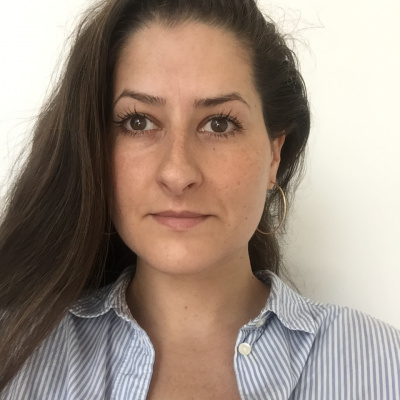Mapping Contortion in Japan — Part Two, The Future
Having explored early traces of contortionism throughout Japan’s entertainment history in Part One of this series, I will now discuss contemporary developments, as well as the establishment of the first contortion studio in Japan in my interview with Ayumi Moco Osanai, the founder of Contortion Studio NUGARA. Osanai has a background in Judo, a Japanese martial art form, and fell in love with contortion during a high school exchange program in Mongolia. She has since studied contortion in Mongolia at the Mongolian National Circus and opened her own contortion studio in Japan in 2015. Studio NUGARA (derived from the Mongolian word “Uran Nugaralt” for Contortion) is the first and currently only contortion studio in Japan, and practitioners from all corners of the country travel to Tokyo to study contortion.
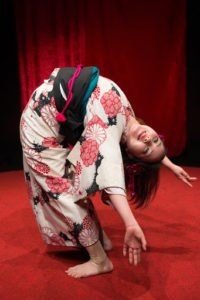
Mariam Ala-Rashi: Thank you for taking the time and sharing your story with us. I would like to begin with your decision to study Mongolian contortion. What was your motivation to study this art form?
Ayumi Moco Osanai: I went to Mongolia through a student exchange programme for about three weeks during high school when I was around seventeen years old. During that time, I watched a traditional Mongolian performance that showcased Mongolian contortion among other traditional art forms. At this moment I fell in love with contortion. It had a very strong impact on me and I started my contortion training immediately.
MA: When did you open the studio and why? What was your mission then and has it changed over the years?
AO: I returned to Mongolia after graduating from University where I studied the Mongolian language here in Japan. I was worried I would lose my abilities and my connection to the art form that I had built during those three weeks at the exchange programme. I opened my studio in 2015 in Tokyo after completing two years of full-time contortion training at the Mongolian National Circus. My coach was Ms Otgontsetseg Darmaa and most of my classmates were children who aimed to become professional contortionists in the future. Furthermore, it is very common that some of them would support their families financially with their income as a performing artist. When returning to Japan after completing my training, I decided to open a small performance space that should both serve as a vessel to introduce contortionism to the Japanese audience, as well as a platform for contortionists from Mongolia who could present their art form here in Japan. It was only later that this space turned into a contortion studio. At the time when I opened this school contortionism was pretty unknown in Japan and most of my students didn’t want to become contortion practitioners. Their interest was just to enhance their body flexibility a little bit. Therefore, I had to adjust and tone down my training methods. However, recently contortion has become more popular and practitioners now aim to become professional contortionists.
I would say my studio has become more than just a training centre for contortion. I think of it now as a community space for contortionists and I hope to increase the popularity of this art form here in Japan.
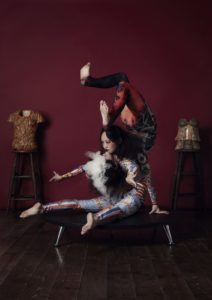
MA: During your training sessions in Mongolia, did your teachers share any knowledge with you and the other students about the history of Mongolian contortion?
AO: Most of the time we focused on the training and therefore the knowledge that was shared with us students was very limited. However, when teaching my classes here in Japan I try to pass on the embodied knowledge that I have gained through practice in Mongolia. I make sure that new students understand that contortion is an art form and not just a fitness trend and that they receive some background information about the Mongolian culture. It is also imperative for new students to understand that a large part of the contortion training focuses on building strength and not just flexibility; a very common misapprehension among beginners about contortion training.
MA: When teaching contortion, do you apply the techniques you have learned in Mongolia or have you developed your own training concept?
AO: The training in Mongolia was very hard and applying the same intensity when teaching adults would not be healthy. I, therefore, adjust accordingly to the students’ needs and use a training programme that I have developed in the past years. The training methods for children, however, are very similar to the way I have studied in Mongolia.
MA: Having explored the history of contortion here in Japan, I hope to gain more insights from a local contortion practitioner. Can you share your knowledge regarding the history of contortion here in Japan?
AO: During the 7th century, a circus from China introduced contortionists among other circus acts to the Japanese audience, however, the circus returned to China and, as far as I know, contortion did not leave a mark in the Japanese entertainment industry at that time. Much later, between the Edo and Showa period, numerous freak shows travelled throughout Japan displaying children with special needs among other performing artists. A young man called Octopus Boy [1], who had a condition that enabled him to dislocate his joints to an extreme level, presented his skills of body flexibility to a wider audience.
Furthermore, there are traces of body flexibility that developed independently during that particular time, where flexible street performers displayed similar poses to what we identify as contortion nowadays. Throughout this period, these travelling street entertainers called “Kakubei Jishi” emerged independently, without any connection to the freak shows. During the act the performer would display his or her body flexibility, wearing a lion mask and perform tumbling tricks. These flexibility acts were not passed on from one performer to another, as it is custom amongst contortion practitioners for example in Mongolia and China, but vanished when the performing artist retired. Today these acts have died out and are considered a cultural heritage of the Niigata prefecture in Japan.
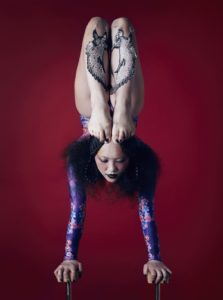
MA: Nowadays contortion has become very popular on a global scale through televised talent shows, and it’s a trending subject on social media with women all over the world displaying their body flexibility and producing tutorials on how to master contortion exercises. How popular is contortion currently in Japan?
AO: I think the trend here in Japan is slowly growing. I have had the opportunity to perform on TV and circus shows multiple times, but we don´t have big talent shows such as “America´s Got Talent.” I hope that my work will boost the contortion culture and introduce this art form to a wider audience.
MA: Do you think of contortion as an art form or a sport, or both?
AO: Both! I think the training is that of an athlete with the final goal to become an artist.
MA: When performing, do you represent the Mongolian style and aesthetic or is your style influenced for example by traditional Japanese culture or anime, Harajuku or pop culture?
AO: I perform and teach the Mongolian style and aesthetic. My students, however, bring other influences into their creative process and performances. Most of them are inspired by European contemporary dance and intertwine dance with contortion movements (Figure 1) and one of my employees, teacher Ash, loves to wear a traditional Kimono during her performances (Figure 2).
I make sure, however, that my students fully understand and appreciate the authentic Mongolian aesthetic and performance style. Only then are they allowed to create their own performances.
MA: What do you think is the development of contortion in Japan and what is its function?
AO: I would say its function is purely for entertainment reasons. I hope that there will be opportunities for audiences to watch a contortion performance whenever they desire, similar to going to the theatre or watching a ballet performance.
MA: Do you think contortion would be acknowledged as an art form here in Japan so that parents would allow their children to become professional contortionists in the future?
AO: I think most parents in Japan would not encourage their children to enter any kind of performative career whether it’s dance, acting or circus. Children would be advised and reminded by their parents to stay humble and pursue an academic career.
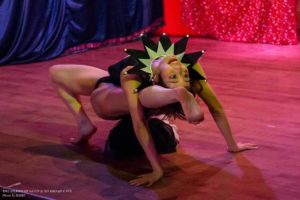
MA: What can you tell me about the circus culture here in Japan?
AO: There are currently three traditional circuses operating in Japan: Kinoshita Circus, Happy Dream Circus and Pop Circus. Although, most performers work as freelancers who have a regular job during the daytime. Some have a part-time contract and some perform with the circus for only two weeks. The employment system within the circus community is very different from that in other countries.
MA: What is the value of contortion in Japan, how is it perceived?
AO: In Mongolia, people simply enjoy the performances as they know it is part of their culture, but in Japan, reactions are very mixed: For some, it is a beautiful art form, others feel uncomfortable watching it or think of it as unnatural and disgusting, again others have a sexual association to contortion.
MA: What can you tell me about the current contortion culture and its community?
AO: As far as I know, there’s just a very small contortion community and network here within this studio and among its practitioners, but I hope of course that this community will grow in the future.
MA: Do you believe that contortion is undergoing a transformation here in Japan and that there will be someday a Japanese influence palpable in the aesthetics and performances?
AO: Well, that is currently hard to tell. But as mentioned before, some performers such as Ash are wearing a traditional Kimono during their performances and intertwine both cultures with each other. I am positive that there will be more development in the future, and I am looking forward to seeing what the next generation of contortionists here in Japan will create.
Conclusion
In conclusion, the present findings, as explored in Part One and Part Two of this article, confirm that despite its incoherent development, mostly documented in illustrations and photographs and rarely in written form, contortion has been practised in Japan for centuries. It will be seen how this art form develops in the context of globalization, televised talent shows and social media, and if there will be a transformation of its aesthetics and function within the Japanese society and growing circus community. With the current establishment of the first contortion studio in Japan, it remains to be seen how contortion will be integrated into the Japanese entertainment industry and how its small community will grow in the future. Since the discontinuation of Kakubeijishi performances in the Meiji era, as explored in part one of this series, the administration of the Niigata prefecture has since acknowledged the Lion Dance as cultural heritage and reinstalled the practice of this art form so that it is displayed in an annual festival as one of the cultural assets of the town. In part three I will discuss the cultural and historical aspects of the Lion Dance with Tomomi Homma, advisor of the Town Development Minami Ward Niigata Prefecture. We will explore the independent development of the Kakubeijishi Lion Dance that showcases unique cultural and spiritual elements of Japan through body flexibility.
Acknowledgments
I would like to express my sincere gratitude to Ayumi Moco Osanai for the interview, to Yargai Galtat for translating between Japanese, Mongolian and English and to Jean-Luc Bedryk for his ongoing support.
References (Part Two)
[1] Furuya, A. (2007). Koumori To Namekuji No Utage Octopus Boy [online] Available at Feast of Bats & Slugs :[Accessed 23.12.2019]
All photos courtesy of Mariam Ala-Rashi. Permission for publication of photographs granted by Ayumi Moco Osanai.Feature photo credit: Reiko Wakai. Contortion Studio Nugara.
Related content: Mapping Contortion in Japan– Part One, A History
...Do you have a story to share? Submit your news story, article or press release.


